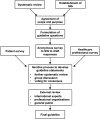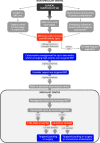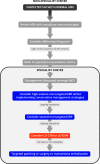Multidisciplinary consensus guideline for the diagnosis and management of spontaneous intracranial hypotension
- PMID: 37147116
- PMCID: PMC10511987
- DOI: 10.1136/jnnp-2023-331166
Multidisciplinary consensus guideline for the diagnosis and management of spontaneous intracranial hypotension
Abstract
Background: We aimed to create a multidisciplinary consensus clinical guideline for best practice in the diagnosis, investigation and management of spontaneous intracranial hypotension (SIH) due to cerebrospinal fluid leak based on current evidence and consensus from a multidisciplinary specialist interest group (SIG).
Methods: A 29-member SIG was established, with members from neurology, neuroradiology, anaesthetics, neurosurgery and patient representatives. The scope and purpose of the guideline were agreed by the SIG by consensus. The SIG then developed guideline statements for a series of question topics using a modified Delphi process. This process was supported by a systematic literature review, surveys of patients and healthcare professionals and review by several international experts on SIH.
Results: SIH and its differential diagnoses should be considered in any patient presenting with orthostatic headache. First-line imaging should be MRI of the brain with contrast and the whole spine. First-line treatment is non-targeted epidural blood patch (EBP), which should be performed as early as possible. We provide criteria for performing myelography depending on the spine MRI result and response to EBP, and we outline principles of treatments. Recommendations for conservative management, symptomatic treatment of headache and management of complications of SIH are also provided.
Conclusions: This multidisciplinary consensus clinical guideline has the potential to increase awareness of SIH among healthcare professionals, produce greater consistency in care, improve diagnostic accuracy, promote effective investigations and treatments and reduce disability attributable to SIH.
Keywords: CSF dynamics; headache; interventional; neuroradiology; neurosurgery.
© Author(s) (or their employer(s)) 2023. Re-use permitted under CC BY-NC. No commercial re-use. See rights and permissions. Published by BMJ.
Conflict of interest statement
Competing interests: JA: remuneration for consultancy advice and education provision from Allergan/AbbVie and TEVA. HA-L: lectures and education paid by International Medical Press, Sanofi and Eisai. LCJ: lecture fees received from Radiopaedia. SC: research fellowship sponsored by Abbott. LD'A: supported by an NIHR Academic Clinical Fellowship and was the recipient of a research fellowship sponsored by B Braun. BD: remuneration for consultancy advice and education provision from TEVA, Allergan and Lilly. PJD: shareholding in BMS, Regeneron and Ionis Pharma. SE: owns the North Midlands Neurosciences. VI: reports speaker fees and honoraria from Theravance Biopharma and Jensen, outside of the present work; supported by the National Institute for Health and Care Research University College London Hospitals Biomedical Research Centre. SL: received fees for attending advisory meetings, presentations and preparing presentation materials from Allergan, TEVA, Eli Lilly and Novartis. MSM: chair of the medical advisory board of the CSF Leak Association, serves on the advisory board for Abbott, Allergan, Novartis, Eli Lilly, Medtronic, Autonomic Technologies and TEVA, and has received payment for the development of educational presentations from Allergan, electroCore, Eli Lilly, Novartis and TEVA. CJ, SM, JP, RS, TT: members of CSF Leak Association. S-JW: received honoraria as a moderator from AbbVie, Pfizer, Eli Lilly and Biogen, and has been the PI in trials sponsored by AbbVie, Novartis and Lundbeck. He has received research grants from the Taiwan Minister of Technology and Science (MOST), Brain Research Center, National Yang Ming Chiao Tung University from The Featured Areas Research Center Program within the framework of the Higher Education Sprout Project by the Ministry of Education (MOE) in Taiwan, Taipei Veterans General Hospital, Taiwan Headache Society and Taiwan branches of Eli Lilly and Novartis.
Figures




Comment in
-
Comment on: multidisciplinary consensus guideline for the diagnosis and management of spontaneous intracranial hypotension.J Neurol Neurosurg Psychiatry. 2024 Jan 11;95(2):196-197. doi: 10.1136/jnnp-2023-331981. J Neurol Neurosurg Psychiatry. 2024. PMID: 37591690 No abstract available.
References
Publication types
MeSH terms
LinkOut - more resources
Full Text Sources
